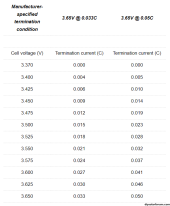Yep, But even in the absence of comms, we can try to closely approximate/approach this with the charging parameters we are provided in our chargers.To implement tail current, you need some kind of communication with your charge controllers to stop putting in power, or a BMS that can limit current.
We can both agree that it is never wise for BMS to do anything regularly regarding charging. It should be the duty of charger.
Even when it comes to communication, it doesn't have to be full fledged communication.
I think it should be very easy to signal just charge request to controller using single conductor pulled HIGH/LOW. Or two differential pairs for long er distances. I'm bad with comms and signalling but I'm sure creative geniuses could easily figure this out.
You're substituting my understanding with your own. It doesn't have to be like that. The charge current going into the battery can stop and let it switch to float.or tell me why I should right away involve my battery to power the load when solar (and the charge controller) can continue to power my load, but are told by the BMS to stop.
That is the question I wanted you to ask all this time! There is an extremely elegant approach to this whole "charging at very low C rates" problem.When in practice, I have a fluctuating source of power from which I want to capture the most amount as possible, and just stopping at 3.5V (or 3.55V) charging voltage will do just that without any balancing issues (again, five years in with my packs if you want real world experience). Also, again, imagine you're at 3.5V (due to a very quick burst of incoming solar) and you have a cloud come over which makes your current drop. How do you distinguish that from meeting the tail current?
Case A: When instantaneous charging current is more than tail current:
Let's assume my equipment can muster 0.25 C charge current.If I'm aiming for 0.05 C cut off @ 3.65V,
I charge until battery voltage rises to 3.65 V/Cell and hold it there until charging current drops to 0.05 C.
You personally want to target 'safer' voltage like 3.5 V/Cell. The corresponding tail current from the table is ~0.02 C. No need to be absurdly precise.
I charge until battery voltage rises to 3.5 V/Cell and hold it there until charging current drops to ~0.02 C.
Case B: When instantaneous charging current dips to less than tail current:
Suppose, our equipment can only muster a C-rate lower than 0.05 C. This is specially applicable for DC benchtop power supply charging multiple cells in parallel with smaller current compared to its capacity.Or that while charging using Case A above, one of your concerns came up.
(due to a very quick burst of incoming solar) and you have a cloud come over which makes your current drop.
Then the calculation is inverted. Now, we look up from the table/calculate the voltage according to our instantaneous charging current and terminate charging when voltage is reached.
So, if the charging current is 0.02 C, charging is considered complete when voltage rises/reaches 3.5 V/Cell.
If the charging current is 0.05 C, charging is considered complete when voltage reaches 3.65V/Cell and so on.
OR If you don't want voltages beyond 3.5V/Cell, once 3.5 V is reached with 0.05 C, the situation flips to Case A. 3.5 V/Cell is then held until current drops to 0.02 C.
For all C-rates below 0.05 C, there exists a voltage below 3.65 V beyond which charging is considered complete.
Just for self-consistency purposes, think about what will happen if charging current is 0.06 C.
Naturally, Case A is followed.
The battery will be charged with 0.06 C until battery voltage rises to 3.65 V/Cell and held until charging current drops to 0.05 C.
At all time, the charging current can be either more or less than what a user-specifies for charging parameter. In either situations, the charging behaviour is determined. And because, I've described all possible situations that can arise, There is no question of ambiguity or things to guess anywhere.
This according to me should be the hallmark of any information complete, self consistent and more even more importantly physically correct implementation. Implementing this elegant logic for a charger is something I guess is less than few pages of code.z
If You've understood this far, then we can proceed further.
Attachments
Last edited:





